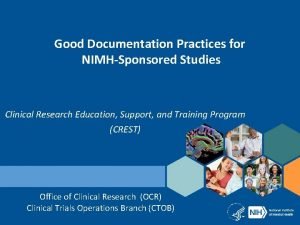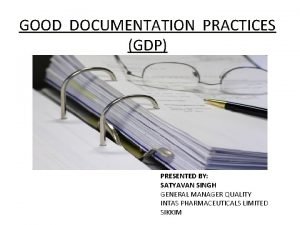Good Teaching Practices What Are They Good Teaching












- Slides: 12

Good Teaching Practices What Are They ?

Good Teaching Practices: An Intro The Chickering and Gamson summary (1987) Seven Principles of Good Practice (GTPs) The technological revolution The Chickering and Ehrmann update (1996 & 2003)

Seven Principles of Good Practice 1. Encourages contact between students and faculty 2. Develops reciprocity and cooperation among students 3. Encourages active learning 4. Gives prompt feedback 5. Emphasizes time on task 6. Communicates high expectations, and 7. Respects diverse talents and ways of learning.

#1: Contact Encourages contact between students and faculty Factor in keeping students motivated and involved Augments face-to-face contact Opportunities:

#2: Reciprocity & Cooperation Develops reciprocity & cooperation among students Collaborative/social vs. competitive/isolated Facilitation of group study, discussions, & problem solving Opportunities: Email, Group Work, Collaborative Tools, Discussion Boards, Wikis And Blogs, Surveys

#3: Active Learning Uses active learning techniques Students can… Talk & write about it Relate it to the past Apply it to the present Opportunities:

#4: Prompt Feedback Gives prompt feedback Critical observation Assessment of knowledge & competence Frequent assessment Opportunities:

#5: Time on Task Emphasizes time on task Allow proper amount of time to complete tasks Set time limits to complete tasks Opportunities:

#6: High Expectations Communicates high expectations A self-fulfilling prophecy; students respond to what is asked of them. Opportunities:

#7: Diversity Respects diverse talents and learning styles Different students = different talents & styles Diversity in race, color, religion, income Diversity also relates to the quality of a student’s educational foundation Opportunities: Learning Units, Folders, groups

Resources for Further Study Chickering and Gamson. “Seven Principles for Good Practice in Undergraduate Education. ” The American Association for Higher Education Bulletin, March, 1987. http: //honolulu. hawaii. edu/intranet/committees/Fac. Dev. C om/guidebk/teachtip/7 princip. htm Chickering and Ehrmann. “Implementing the Seven Principles: Technology as Lever. ” The TLT Group: Teaching, Learning, and Technology. (Originally published in AAHE Bulletin, October, 1996, pp. 3 -6). http: //www. tltgroup. org/programs/seven. html

Resources for Further Study Chickering & Gamson. “Development and Adaptations of the Seven Principles for Good Practice in Undergraduate Education. ” New Directions for Teaching and Learning, no. 80, Winter 1999. http: //www. umflint. edu/resources/centers/tclt/resources/ evaluating_teaching/pdfbin/Development%20 and%20 Adaptations%20 of%20 the%2 0 Seven%20 Principles%20 for%20 Good%20 Practice%20 in%2 0 Undergraduate%20 Education. pdf
 Mikael ferm
Mikael ferm Good thoughts good words good deeds
Good thoughts good words good deeds Hello good morning good afternoon
Hello good morning good afternoon Good afternoon animado
Good afternoon animado You are good when theres nothing good in me
You are good when theres nothing good in me Good morning good afternoon
Good morning good afternoon Good documentation practices
Good documentation practices Gmp regulations
Gmp regulations Good manufacturing practices in pharmaceutical industry
Good manufacturing practices in pharmaceutical industry Glp standards
Glp standards Alcoac
Alcoac Gmp meaning
Gmp meaning Document
Document























